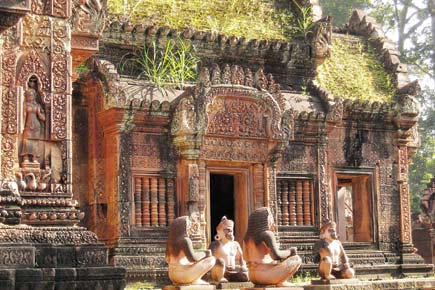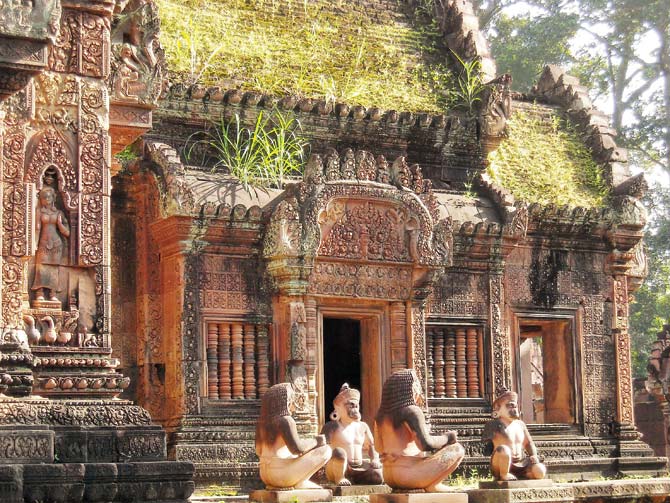Onsite museums are as vital as the site itself. Cambodia's efforts in this direction can serve as apt lessons for our babus in Mumbai who continue to ignore the steady ruin at Elephanta Caves


Banteay Srei temple in Cambodia
ADVERTISEMENT
 We had reached the final leg of our inspiring trip of Angkor, the megacity of temples and monuments in Cambodia. We'd been introduced to some of the finest examples of Khmer architecture - including the once-in-a-lifetime opportunity of setting our eyes on the largest religious monument in the world - the 12th century Angkor Wat temple.
We had reached the final leg of our inspiring trip of Angkor, the megacity of temples and monuments in Cambodia. We'd been introduced to some of the finest examples of Khmer architecture - including the once-in-a-lifetime opportunity of setting our eyes on the largest religious monument in the world - the 12th century Angkor Wat temple.
It was an hour-long drive on pock-marked non-roads, to the foot of the Kulen Mountains, away from the main concentration of temples. We crossed paddy fields, thatched roof homes and bubbly village kids bathe in rain-fed lakes to reach the remarkably small temple site of Banteay Srei (Citadel of women/beauty); it dwarfed in comparison to the mammoth structures in the nucleus of the site. Its miniature scale surprised us, and yet the intricate carvings in pink sandstone, and near-total decoration on its facades blew our minds. A closer look at the gopuras, garudas, lions and life-like monkeys acting as sentries could've easily transported us to a temple town in southern India.
We marvelled at the interpretations of the Mahabharata and Ramayana here, routinely hailed by local and world archaeologists, planners and historians as the 'Jewel of Khmer Art'. Towards one end, our attention was drawn to a small museum. It showcased the restoration of Banteay Srei between 1931 and 1936 that involved the first significant use of anastylosis - a highly advanced technique that restores buildings with minimal damage to the original site. We hit flashback mode, as frames of another UNESCO World Heritage Site closer home came to mind - Elephanta Caves. It's where the likeness ended.
The documentation, chronicling of timelines and ease of communication for visitors of all nationalities at this mini museum was applause-worthy. The layout was filled with replicas of original sculptures, panels, lintels and pediments, and black-and-white giant-sized photo frames with captions that were stories in themselves. The planner(s) of this museum went through great pains to ensure that each phase of restoration was showcased. Despite having just visited the site and studied each contour with religious dedication, the museum had opened a whole new world of information about the temples, its history and restoration. We spent an hour here, from entry to exit. That balmy morning in September at a far-off heritage site in a genocide-ravaged country was an eye-opener in several ways.
We're not sure how many of our readers would have visited the museum (we'd rather call it hallway) at the Elephanta Caves but we might as well play killjoy, and forewarn you. It is an appalling sight, and a poor reflection of the rich heritage that lies beyond, in its ancient caves. For a first-timer to the site, after an arduous walk up 100-plus stairs, this could be the most off-putting part of their visit. Why this space continues to fall off the radar of the powers that be defies logic and reason, especially since it remains just one of the two sites on the prestigious UNSESCO WHS list from Mumbai (CST being the other one). Each time we set foot on the isle, an even more painful reminder awaits us, of the neglect and danger (read: vandalism) that the site lies exposed to.
As International Museum Day approaches, we can only hope that efforts are made to revive Mumbai's lone onsite museum and give it a place of pride and respect like its permanent counterparts on the mainland.
mid-day's Features Editor Fiona Fernandez relishes the city's sights, sounds, smells and stones...wherever the ink and the inclination takes her. She tweets @bombayana Send your feedback to mailbag@mid-day.com
 Subscribe today by clicking the link and stay updated with the latest news!" Click here!
Subscribe today by clicking the link and stay updated with the latest news!" Click here!






